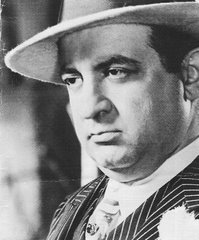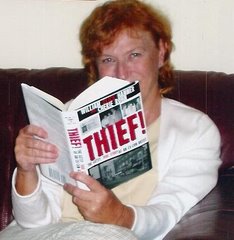
This review appeared Sunday, April 13, 2008 and will run for a week:
DEAD MENS' HANDS
By CHERIE ROHN
April 13, 2008 -- "McCall, who had quietly moved behind Hickok, pulled a gun from under his jacket and shot him, crying out, 'Damn you, take that.' The bullet drilled a hole in Hickok's head and went on to hit Massie in the wrist. Hickok died instantly and fell silently to the floor."
By CHERIE ROHN
April 13, 2008 -- "McCall, who had quietly moved behind Hickok, pulled a gun from under his jacket and shot him, crying out, 'Damn you, take that.' The bullet drilled a hole in Hickok's head and went on to hit Massie in the wrist. Hickok died instantly and fell silently to the floor."
The lesson? Never hold aces and eights. And, according to New Zealand author Des Wilson, who recreates the demise of Wild Bill Hickok during that famous poker game, know that "the key to [poker's] popularity is its history."
"The players, even the youngest, know it comes from the back alley, the gangster's den, the Western saloon," Wilson writes. "They know there was a time when there were guns in the game . . . they know there are ghosts at the table."
Wilson's history is divided into four ages: the old frontier, the road gamblers, Las Vegas and the modern poker explosion. He scoured the archives and crisscrossed the country exploring the places where poker legends plied their trade from dusty, remote Tombstone and Dodge City, the stomping grounds of Wyatt Earp and Doc Holliday; to the Mississippi riverboats where you didn't lose at poker, you were robbed or worse; to the Texan road gamblers like Johnny Moss, Sailor Roberts and Amarillo Slim who "faded the white line" driving from game to game. The object was to leave with the money they'd won, keep it and stay alive long enough to enjoy it. "It's these poker people who give the game its special aura," Wilson says.
Wilson identifies poker's special characters and dispels some of the more fanciful fabrications. In a game that has largely remained illegal, whose rich stories were passed on by word of mouth, it's no wonder the line between myth and reality fuzzes over.
Such is the case with Benny Binion, who established the World Series of Poker at the Horseshoe in Las Vegas and nurtured it for 35 years. While building a fortune running the Horseshoe, Binion said, "If you want to get rich, make little people feel big." But as Wilson explains, "every now and then the mask would drop and Benny's ruthlessness would emerge." Binion's now famous words after a Mafia hit man claimed Binion hired him were "I'm capable of doing my own killing."
Wilson has no qualms asking former World Series of Poker director Eric Drache about the cheating and rumors of collusion that went on during the early days of the World Series and "fixing" the main event in 1972. Nor is Wilson afraid to call a spade a spade when he describes major hitters like Stu Unger, who Mike Sexton called "the greatest no-limit poker player ever to have played the game." Unger blew it all over cocaine, dead by 45.
Ultimately, it's the World Series of Poker in Las Vegas that takes center stage. This battle of the titans has grown from a handful of players in 1970 with a major prize of $100,000 to an international field of 54,000 in 2007 with a staggering $60 million main event prize.
As the World Series ratchets up the stakes, it also attracts a new breed of Internet poker whiz kids to its ranks who give the old guard a run for their money. As evidence, Wilson observed during the 2007 World Series "four of the final table are either Internet professionals or play most of their poker online." Perhaps more important, he adds that "the world's most popular game is in good shape."
Cherie Rohn co-authored Thief! The Gutsy True Story of an Ex-Con Artist.
Ghosts at the Table
A History of Poker
by Des Wilson
Da Capo Press
A History of Poker
by Des Wilson
Da Capo Press



No comments:
Post a Comment